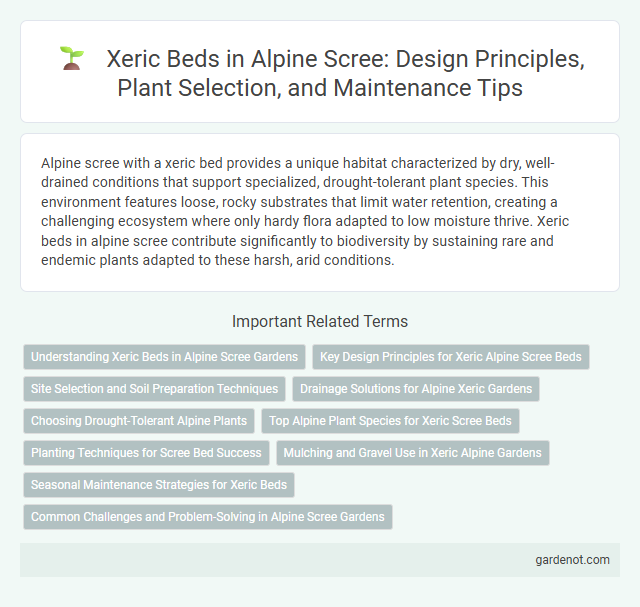Alpine scree with a xeric bed provides a unique habitat characterized by dry, well-drained conditions that support specialized, drought-tolerant plant species. This environment features loose, rocky substrates that limit water retention, creating a challenging ecosystem where only hardy flora adapted to low moisture thrive. Xeric beds in alpine scree contribute significantly to biodiversity by sustaining rare and endemic plants adapted to these harsh, arid conditions.
Understanding Xeric Beds in Alpine Scree Gardens
Xeric beds in alpine scree gardens simulate dry, well-drained environments essential for drought-tolerant plants like sedums, saxifrages, and alpines. The soil composition combines coarse gravel, sand, and minimal organic matter to mimic natural scree slopes, ensuring rapid water drainage and preventing root rot. Selecting and maintaining xeric beds promotes healthy plant growth and sustains biodiversity in harsh alpine conditions.
Key Design Principles for Xeric Alpine Scree Beds
Xeric Alpine Scree Beds require well-draining substrates composed of coarse gravel and sand to mimic natural mountain scree conditions, ensuring minimal water retention. Plant selection emphasizes drought-tolerant alpine species with deep root systems that stabilize the bed and thrive in nutrient-poor soils. Strategic layering and slope design enhance air circulation and prevent soil compaction, promoting optimal growth and sustainability in xeric environments.
Site Selection and Soil Preparation Techniques
Site selection for xeric beds in alpine scree environments prioritizes well-drained, nutrient-poor soils with high mineral content to mimic natural conditions. Soil preparation techniques include the incorporation of coarse sand, gravel, and organic matter to enhance drainage and aeration while preventing water retention that can harm drought-tolerant alpine plants. Optimal preparation ensures a stable substrate promoting root penetration and minimizing soil erosion in harsh, exposed scree habitats.
Drainage Solutions for Alpine Xeric Gardens
Alpine xeric gardens require efficient drainage solutions to manage rapid water runoff and prevent root rot in rocky scree environments. Implementing well-graded gravel layers and perforated drainage pipes enhances water percolation, maintaining optimal soil moisture levels essential for drought-tolerant alpine plants. Incorporating native alpine scree materials further improves soil aeration and mimics natural xeric bed conditions, promoting healthy plant growth.
Choosing Drought-Tolerant Alpine Plants
Selecting drought-tolerant alpine plants for a xeric bed in Alpine scree involves prioritizing species like Sedum, Sempervivum, and Saxifraga, which thrive in well-drained, rocky soils with minimal water. These plants exhibit adaptations such as succulent leaves and deep root systems that enhance water retention and resilience to dry conditions. Incorporating native alpine species ensures ecological compatibility and sustainable growth in harsh, drought-prone environments.
Top Alpine Plant Species for Xeric Scree Beds
Top alpine plant species for xeric scree beds include Saxifraga oppositifolia, Silene acaulis, and Draba aizoides, which are well-adapted to dry, rocky environments with minimal soil moisture. These species exhibit specialized root systems and drought-resistant features that enable survival in nutrient-poor substrates typical of alpine scree. Their physiological adaptations, such as reduced leaf surface area and high UV tolerance, optimize water retention and photosynthesis under extreme alpine microclimatic conditions.
Planting Techniques for Scree Bed Success
Xeric beds in alpine scree require well-draining, gritty soil to prevent root rot and mimic natural conditions. Planting techniques emphasize spacing for air circulation and careful selection of drought-tolerant species such as sedums, saxifrages, and alpine asters. Incorporating sharp sand or crushed stone enhances drainage, promoting healthy root development and sustained growth in these challenging environments.
Mulching and Gravel Use in Xeric Alpine Gardens
Mulching with organic materials in xeric alpine gardens enhances soil moisture retention and temperature regulation, crucial for fragile alpine scree environments. Gravel use not only improves drainage but also mimics natural scree substrates, promoting plant stability and root aeration. Combining mulching and gravel optimizes water conservation and soil health, supporting resilient xeric bed ecosystems.
Seasonal Maintenance Strategies for Xeric Beds
Seasonal maintenance strategies for xeric beds in alpine scree environments emphasize soil aeration and selective weeding to preserve drought-resistant plant health. Mulching with gravel or decomposed granite helps regulate soil temperature and retain moisture during dry seasons, minimizing water stress. Regular inspection and removal of invasive species ensure that native xerophytic flora thrive in these nutrient-poor, well-drained habitats.
Common Challenges and Problem-Solving in Alpine Scree Gardens
Xeric beds in alpine scree gardens face challenges such as poor soil moisture retention and extreme temperature fluctuations that stress plant roots. To address these issues, gardeners implement well-draining substrates combined with organic matter to balance moisture levels and use drought-tolerant alpine species adapted to harsh conditions. Proper site selection and rock placement enhance microclimates, reducing water loss and providing shelter from wind desiccation.
Xeric bed Infographic

 gardenot.com
gardenot.com